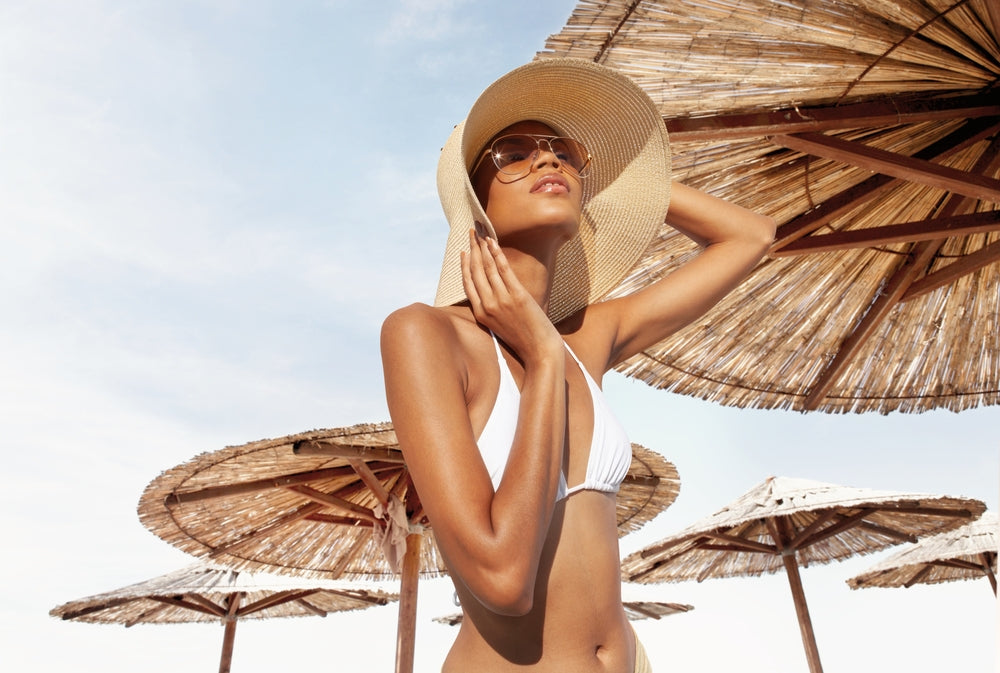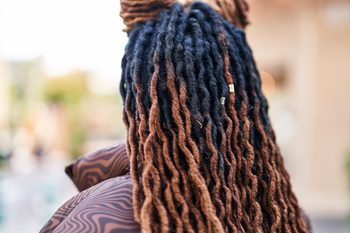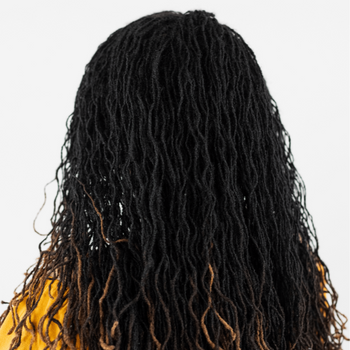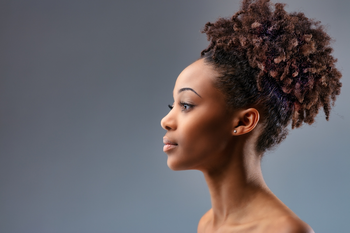

Natural hair sun protection becomes essential when you understand that sunlight contains UV rays that can oxidize and break down pigment molecules in your hair, leading to color fading. The effect of the sun on hair extends beyond color changes—excessive exposure to UVA/UVB rays can damage melanin and the hair shaft itself. However, with the right approach, you can protect your hair from the sun and maintain healthy hair throughout the warm season.
Table of Contents
What the Sun Actually Does to Natural Hair
The sun emits UVA and UVB ultraviolet radiation that affects your natural hair. UVB impacts the outer cuticle layer, causing protein loss, while UVA penetrates deeper into the cortex, leading to color changes.
UV exposure triggers photochemical degradation by attacking hair proteins and melanin. The radiation breaks down essential amino acids like cystine and methionine, producing free radicals that damage keratin, your hair's main protein. This process ruptures crucial disulfide bridges that maintain your hair's strength and shape.
Sun exposure also damages the natural hair's external lipid layer, which usually protects against moisture loss. UV oxidation degrades these lipids, resulting in reduced shine and hydration. Curly and coily hair textures are particularly vulnerable since natural oils already struggle to travel down curved strands.
Melanin offers some natural UV protection by absorbing and dispersing radiation as heat, making darker hair more resistant. However, this protective melanin degrades over time, eventually leading to visible sun damage in all hair types.
The overall impact is both cosmetic and structural, affecting the health and manageability of your natural hair.
Signs Your Hair is Sun-Damaged
Spotting sun damage in your natural hair doesn't require a microscope—just knowing what to look for. After repeated sun exposure, your hair will send clear distress signals that shouldn't be ignored.
Color Changes: Has your vibrant hair color become dull or brassy? UV rays break down hair pigments, causing your natural or colored hair to fade and develop unwanted tones.
Texture Transformation: Your hands can feel sun damage before your eyes see it. Healthy hair feels smooth and soft, whereas sun-damaged strands feel rough and straw-like to the touch. Furthermore, if your once-manageable hair suddenly feels crunchy or brittle, excessive sun exposure is likely the culprit.
Structural Damage Signs:
Increased breakage with minimal handling
More split ends than usual, especially during the summer months
Difficulty detangling after washing
Hair that dries unusually quickly after getting wet
Visible Surface Changes: The sun weakens your natural hair's protective cuticle layer, causing it to lift slightly. This lifting creates the perfect storm for frizz and roughness, even in hair types not typically prone to these issues.
Loss of Moisture and Shine: UV rays strip away the natural oils that give your hair its healthy gleam. As a result, sun-damaged hair looks dull and lacks the natural sheen that healthy strands reflect.
Elasticity Issues: Healthy hair naturally has stretch and bounce. In contrast, when UV radiation damages the protein structure of your hair, it loses elasticity and becomes more prone to snapping rather than stretching when pulled
Scalp Symptoms: Don't forget your scalp—it's the foundation of your hair. Signs of sun damage include tenderness, redness, peeling, and sometimes small, fluid-filled blisters in severe cases. This damage can disrupt healthy hair growth at the source.
For textured or natural hair, these symptoms may be particularly pronounced, as curl patterns often struggle with moisture retention. Identifying these warning signs early allows you to take protective action before more serious damage occurs.
8 Prevention Tips to Protect Natural Hair from the Sun
Protecting your natural hair from the sun requires a multi-faceted approach. Just as you shield your skin, your hair deserves the same level of care against harmful UV rays. Here are eight effective prevention strategies to keep your natural locks healthy throughout sunny seasons.
1. Cover Up With Hats and Scarves The simplest yet most effective protection comes from physical barriers. Wide-brimmed hats provide excellent coverage for both your hair and scalp. Opt for hats made from natural fibers for breathability. For maximum protection, opt for scarves made from silk or satin instead of cotton, which can absorb moisture and cause friction.
2. Apply UV-Protective Products. Many leave-in conditioners now contain UV filters that help shield your hair from sun damage. Products with ingredients like coconut oil (which has a natural SPF of approximately 4-10) provide a protective barrier against UV radiation. Thermal protectants can perform double duty by guarding against both styling heat and sun exposure.
3. Rock Protective Styles: Styles like braids, twists, buns, and top knots minimize the surface area of hair exposed to direct sunlight. The high ponytail and French braid not only protect your scalp but also reduce overall hair exposure to UV rays. These styles can simultaneously protect your natural hair and showcase your creativity.
4. Time Your Outdoor Activities Limit extended sun exposure between 10 a.m. and 4 p.m. when UV radiation reaches its peak intensity. Indeed, planning outdoor activities around these hours significantly reduces potential damage to your natural hair.
5. Deep Condition Regularly: Weekly deep conditioning treatments are essential, especially during the summer months. These treatments replenish moisture lost through sun exposure and help repair protein damage caused by the sun. Allow your deep conditioner to penetrate for 20-30 minutes under a plastic cap for maximum benefit.
6. Use Natural Oils Strategically. Oils like coconut, argan, and jojoba can act as natural sun barriers while nourishing your hair. Apply these oils before sun exposure, focusing on the canopy (top layer) of your hair, which receives the most direct sunlight. This method creates a protective shield against UV damage.
7. Hydrate Inside and Out. Internal hydration is just as crucial as external moisture. Drinking plenty of water ensures your body, scalp, and hair receive adequate hydration. This fundamentally strengthens your natural hair's resilience against environmental stressors like UV radiation.
8. Rinse After Swimming. Chlorine and saltwater compound sun damage by further drying out your hair. Rinse your hair immediately after swimming to remove these residual chemicals and minerals. Afterward, apply a leave-in conditioner to restore moisture balance.
Conclusion
Your natural hair needs protection from sun damage year-round. While melanin offers some defense, UV rays can still harm hair structure, breaking down proteins and disrupting bonds. Watch for signs like color fading, rough texture, and breakage to prevent severe damage.
Protect your natural hair by wearing hats or scarves and using products with UV protection. Protective styles help minimize exposure, while deep conditioning and natural oils repair and shield strands. Like skincare, consistent sun protection is key for hair health.
Implement these protective measures today, rather than waiting for damage to occur. Your hair will stay healthy despite sun exposure.
Frequently Asked Questions
How does sun exposure affect natural hair?
Sun exposure can damage the hair's structure by breaking down proteins and disrupting disulfide bridges. This leads to weakened strands, color fading, and increased dryness and brittleness. UV rays also strip away natural oils, leaving hair more vulnerable to damage.
What are some signs of sun-damaged hair?
Signs of sun-damaged hair include color fading, rough and straw-like texture, increased breakage, difficulty detangling, loss of shine, and reduced elasticity. You may also notice more split ends and frizz, especially during summer months.
How can I protect my natural hair from sun damage?
To protect your hair from sun damage, use UV-protective products, wear hats or scarves, opt for protective hairstyles like braids or buns, deep condition regularly, and apply natural oils like coconut or argan oil before sun exposure. It's also advisable to limit outdoor activities during peak UV hours.
Are there any natural sun protectants for hair?
Yes, some natural oils provide sun protection for hair. Coconut oil, for example, has a natural SPF of 4 to 10. Other options include grapeseed oil mixed with rosewater, which can help replenish moisture and protect against sun damage. However, these should be used in conjunction with other protective measures for best results.
How often should I wash my hair to prevent sun damage?
The frequency of washing depends on your hair type. While clean hair is more resistant to sun damage, overwashing can strip natural oils. For most hair types, washing two to three times a week with a mild, sulfate-free shampoo is sufficient. Always use warm water instead of hot, and consider using a UV-protectant leave-in conditioner after washing.




